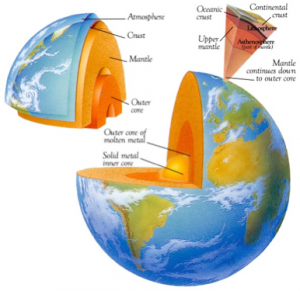Geoneutrinos
Our great old planet has kept since its birth many long lived radioactive atomic nuclei (238U, 235U, 232Th, 40K). This is what we call “natural radioactivity”. This radioactivity is quite huge but badly known. The power coming from it is estimated to be about 20 Tera Watts (TW) (about 20,000 nuclear plants!) and the antineutrinos (ν) coming from this radioactivity are numerous: about 6 millions per second and per cm2.
In 2010 Borexino [Bel10], in Italy, released its first geoneutrino measurement, complemented in 2013 [Bel13]. With 24 interactions attributed to geoneutrinos, Borexino estimated the heat released to be 23-26 TW.
Although still rather uncertain, the heat released by the radioactivity in the Earth represents an important fraction of the total heat released measured as 47 TW.
In 1993 J.M. Herdon [Her93] postulated the existence of a fast neutron breeder reactor at the center of the Earth. This proposition, very controversial in the geoscience community, could explain the measured abundance of 3He in oceanic basalt. It could offer also an explanation to the production of the Earth magnetic field.
Several projects dedicated to the measurements of geoneutrinos have been proposed like Hano-Hano close to Hawaii, Lena in Finland and SNO+ in Canada. The various locations allows to disentangle the contribution due to the crust and to the mantle of the Earth.
Since 2005 regular symposium gathers neutrino physicists and specialists of geosciences. The last one was held in Paris in 2015.
Studies of the Earth
There already exists some proposals to use high energy atmospheric neutrinos or man-made neutrino beams to make an Earth tomography, ie to provide a map of the matter density inside our planet. One of the most spectacular and somehow futuristic was described in [Ruj83]. The idea consisted of an accelerator of particles producing an orientable beam of neutrinos. This device would be on a vessel of a size similar to an aircraft carrier. Neutrinos having crossed the Earth would be detected on a movable detector on the other side of the planet. Such a device could produce a full image of the interior of the Earth either by measuring the attenuation or by using the change of flavor induced by the matter effect.
The large neutrino telescopes infrastructures is also an opportunity to deploy oceanographic, geophysical and biological instrumentation in deep-sea environment, allowing long-term and real-time investigations.The KM3NeT deep-sea installations in France and in Italy already provide access to the Earth and Sea science community.
Further information
During the conference on the History of the Neutrino (Sept. 5-7, 2018 in Paris) the history of Geoneutrinos was reviewed by L. Ludhova (Forschungszentum Julich, Germany) : here the slides , the video of her talk and her contribution to the Proceedings.
For recent developments on the topics : Wikipedia on Geoneutrinos
References
| Author(s) | Title | Reference | Key-words | |
|---|---|---|---|---|
| Ara05 | T. Araki et al., KamLAND collaboration | Experimental investigation of geologically produced antineutrinos with KamLAND | Nature 436 (2005) 499 | historical geoneutrino geobib milestonebib overviewbib |
| Bel10 | G. Bellini et al. | Observation of Geo-neutrinos | Phys. Lett. B687 (2010) 299; arXiv:1003.0284 | historical geoneutrino geobib overviewbib |
| Bel13a | G. Bellini et al. , Borexino collaboration | Measurement of geo-neutrinos from 1353 days of Borexino | Phys. Lett. B722 (2013) 295; arXiv:1303.2571 | geoneutrino geobib |
| Bel13b | G. Bellini, A. Ianni, L. Ludhova, F. Mantovani, W.F. McDonough | Geo-neutrinos | Prog. in Part. and Nucl. Phys. 73 (2013) 1; arXiv:1310.3732 | review progpn geoneutrino geobib |
| Ede66 | G. Eder | Terrestrial neutrinos | Nucl. Phys. 78 (1966) 657 | historical geoneutrino geobib |
| Fio03 | G. Fiorentini, F. Mantovani and B. Ricci | Neutrinos and energetics of the Earth | Phys. Lett. B557 (2003) 139 | geoneutrino geobib |
| Fio07 | Gianni Fiorentini, Marcello Lissia, Fabio Mantovani | Geo-neutrinos and earths’s interior | Physics Reports 453 (2007) 117 | review physrep geoneutrino geobib |
| Gan11 | A. Gando et al., KamLAND collaboration | Partial radiogenic heat model for Earth revealed by geo-neutrino measurements | Nature Geoscience 4 (2011) 647 | geoneutrino geobib detectorbib |
| Her06 | J.M. Herndon | Solar System Processes Underlying Planetary Formation, Geodynamics and the Georeactor | Earth, Moon and Planets 99 (2006) 53 Neutrino Geophysics Proceedings of Neutrino Sciences 2005 | geoneutrino geobib |
| Jav10 | M. Javoy et al. | The chemical composition of the Earth: enstatite chondrite model | Earth Plan. Sci. Lett. 293 (2010) 259 | geoneutrino geobib |
| Kra84 | L. Krauss, S.L. Glashow, D.N. Schramm | Antineutrino Astronomy and Geophysics | Nature 310 (1984) 191 | geoneutrino geobib |
| Mar12 | J.C. Mareschal, C. Jaupart and L. Iarotski | Geoneutrinos and the energy budget of the Earth | J. Geodynamics 54 (2012) 43 | geoneutrino geobib |
| Mar69 | G. Marx | Geophysics by neutrinos | Czech. J. Phys. B 19 (1969) 1471 | historical geoneutrino geobib |
| Mcd95 | W.F. McDonough and S.S. Sun | The composition of the Earth | Chem. Geol. 120 (1995) 223 | geoneutrino geobib |
| Rag98 | R.S. Raghavan, S. Schonert, S. Enomoto, J. Shirai, F. Suekane, A. Suzuki | Measuring the global radioactivity in the Earth by multidetector antineutrino spectroscopy | Phys. Rev. Lett. 80 (1998) 635 | geoneutrino geobib |
| Rot98 | C.G. Rothschild, M.C. Chen and F. Calaprice | Antineutrino geophysics with liquid scintillator detectors | Geophysical Research Letters 25 (1998) 1083 | geoneutrino geobib |
| Ruj83 | A. de Rujula, S.L. Glashow, R. Wilson, G. Charpak | Neutrino Exploration of the Earth | Physics Reports 99 (1983) 341 | review physrep geoneutrino accelerator geobib |

